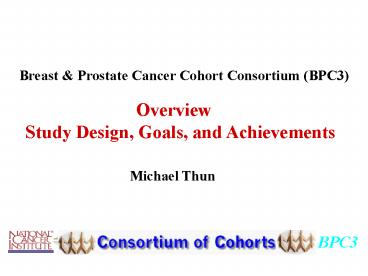Management and Integration Across Sites PowerPoint PPT Presentation
1 / 16
Title: Management and Integration Across Sites
1
Breast Prostate Cancer Cohort Consortium (BPC3)
Overview Study Design, Goals, and Achievements
Michael Thun
BPC3
2
Rationale for Consortia
Genetic research on inherited cancer
susceptibility constrained by
- - Problem of false negatives false positives
from underpowered single studies (especially for
gene-gene gene-environment
interactions) - - Previously no mechanism for planned
replication of findings - - Inadequate standardization of genetic methods
in association studies - - Insufficient communication across relevant
disciplines
3
Rationale for BPC3
- Breast prostate cancer most common cancers in
men and women respectively. - Steroid hormone and IGF pathways relevant to
both sites - Strong evidence for unexplained component of
inherited genetic susceptibility to breast and
prostate cancer - Limited reproducibility of published findings
4
Specific Aims of BPC3
- Comprehensively survey variation in candidate
genes in steroid hormone and IGF metabolism
pathways - Assess associations of SNPs and haplotypes with
breast and prostate cancer - Assess associations with plasma steroid hormone
levels and IGF levels - Examine effect modification by steroid hormone
levels - Assess effect modification by established breast
and prostate cancer risk factors - 6. Establish a network of epidemiologists, human
geneticists and statisticians for collaborative
studies
5
Candidate Genes of Interest Steroidogenic
Pathway
Testis/Ovary
Prostate/Breast
LHCGR FSHR Steroidogenesis Cholesterol
STAR CYP11A1 CYP17 HSD3
HSD17B ?4 A-dione, T,E1, E2
Steroid Receptors ESR1, ESR2, AR
SRD5A2 ?4 A, T DHT
E1,E2 Inactivation
Metabolism HSD3A HSD3B
CYP1A1 CYP1B1
CYP3A4 COMT
Hypothalmus GNRH Pituitary GNRHR CGA LHB FSHB
LH FSH
T E1 E2 SHBG
CYP19
Four HSD3 genes and four HSD17B genes
6
Candidate Genes of Interest Growth Hormone and
Insulin-like Growth Factor Pathways
IGF
Growth Factor
GH1 GHR GHRH GHRHR SST - somatostatin
SSTR1-SSRT5 (somatostatin receptors) POU1F1
pituitary specific transciption
factor
7
Number of Cases from Each Cohort in Proof of
Principle Study
8
Organizational Structure BPC3
Harvard cohorts
ACS cohort
EPIC cohort
Multiethnic cohort
PLCO cohort
ATBC cohort
Laboratories for Gene sequencing, SNP
Identification Haplotypes Genotyping
IARC
Harvard
Cambridge
USC
U. Hawaii
GENOTYPING Working group
Data Pooling Centers
STEERING COMMITTEE
Secretariat
PUBLICATIONS Working group
POPULATION GENETICS Working group
STATISTICS Working Group
9
Flow of Genetic Information
Gene Sequencing SNP Identification Selection of
htSNPs
Genotyping
DNA from Cohorts
IARC
Harvard
Cambridge
USC
Hawaii
NCI
Assay Validation Quality Control Group Purchasing
Data Pooling Centers
Writing teams
10
Flow of Information on Environmental Factors
Harvard cohorts
ACS cohort
EPIC cohort
Multiethnic cohort
PLCO cohort
ATBC cohort
Inventory Covariate Data Standardize
Coding Conduct Initial Analyses
Data Pooling Centers
Writing teams
11
Timeline- Breast Prostate Study
Oct 2000 Study Concept Endorsed by NCI
Jul-Dec 2002 Reviews by NIH NCI Executive
Committee Advisory Board
Jan 2005 18 Month Progress Review
May 2007 Funding Ends
Apr 2003 Grant Funded
Feb 02 Grant Submitted
12
Progress to date
- Established a mechanism to
- Perform detailed comprehensive
characterization of candidate genes - Conduct highly standardized genetic analyses in
large-scale prospective association studies - Systematically evaluate pathways
- Validate promising findings from other approaches
(such as whole gene amplification)
13
Other Progress
- David Altshuler will describe the progress of
BPC3 in characterizing the candidate genes and
making this information immediately available on
the Web. - David Hunter will describe the progress of BPC3
in conducting highly standardized
cost-effective genotyping and then integrating
this with prospectively collected data on risk
factors from the cohorts. He will describe some
early results and discuss possible future
directions of the consortium.
14
(No Transcript)
15
Interim Goals Comparing Minimum 18-month
Performance Criteria to Actual Accomplishments (1)
- Performance Criteria
- Organizational Needs
- Hold Monthly Conference Calls and Semi-Annual
Meetings - Establish Subcommittees
- Determine Work Scope and Data Sharing Methods
- Identify Data Availability Calculate Power
- Prepare a Quality Control Plan
- Genetic Plans
- Resequencing
- Develop Haplotype and Haplotype Tags
- Share Data Across Genotyping Centers
- Identify Specific Case-Control Groups
- Genotype
16
Interim Goals Comparing Minimum 18-month
Performance Criteria to Actual Accomplishments (2)
- Performance Criteria
- Data Congruency
- Identify Common Questionnaire Elements
- Determine Methods for Parallel Analyses
- Develop Plans to Share Pooled Data Internally
- Extra Credit
- Draft Methods Paper Describing Consortium
- Have Results from Parallel Analyses for First
Genes Typed - Complete Pooled Analyses for First Genes Typed
- Preliminary Manuscript for Multivariate Analyses
of Gene-Environment Interactions for Prostate
Cancer - Preliminary Manuscript for Multivariate
Analyses of Gene-Environment Interactions for
Breast Cancer

